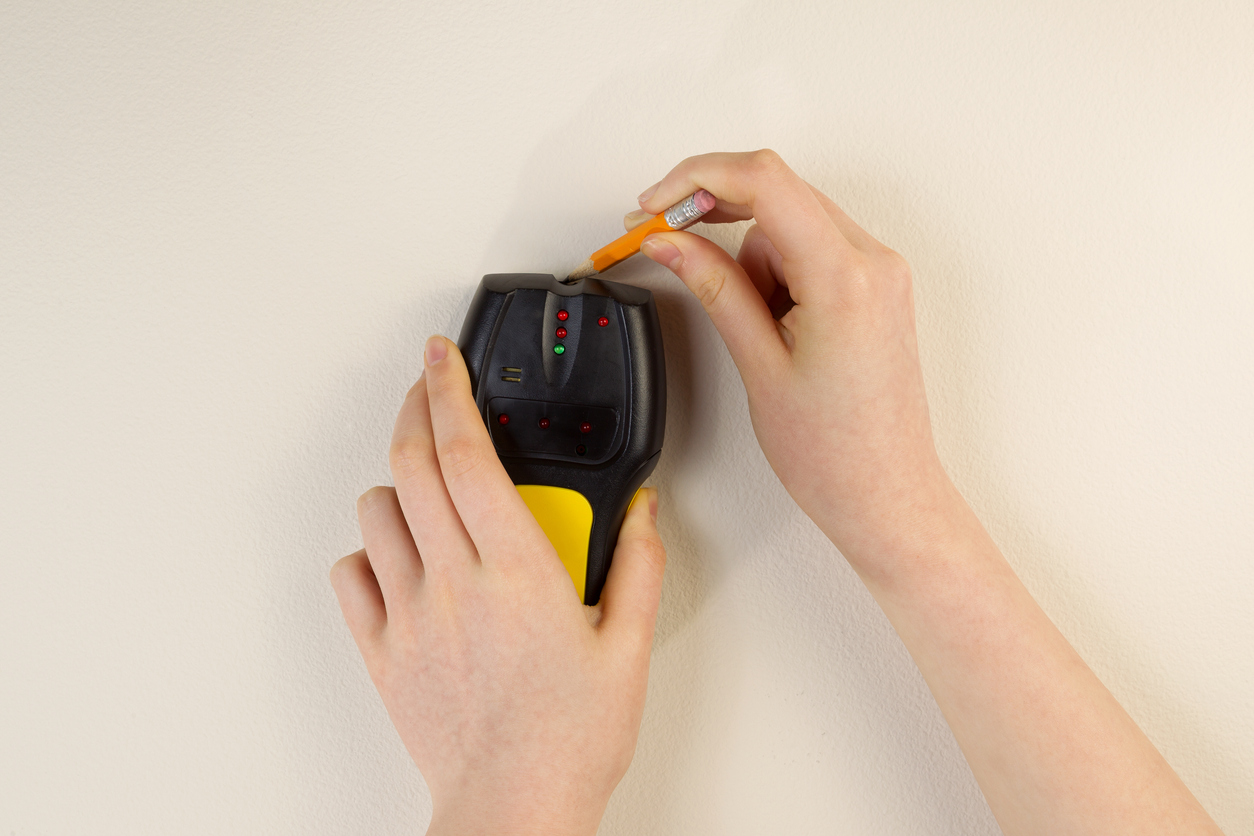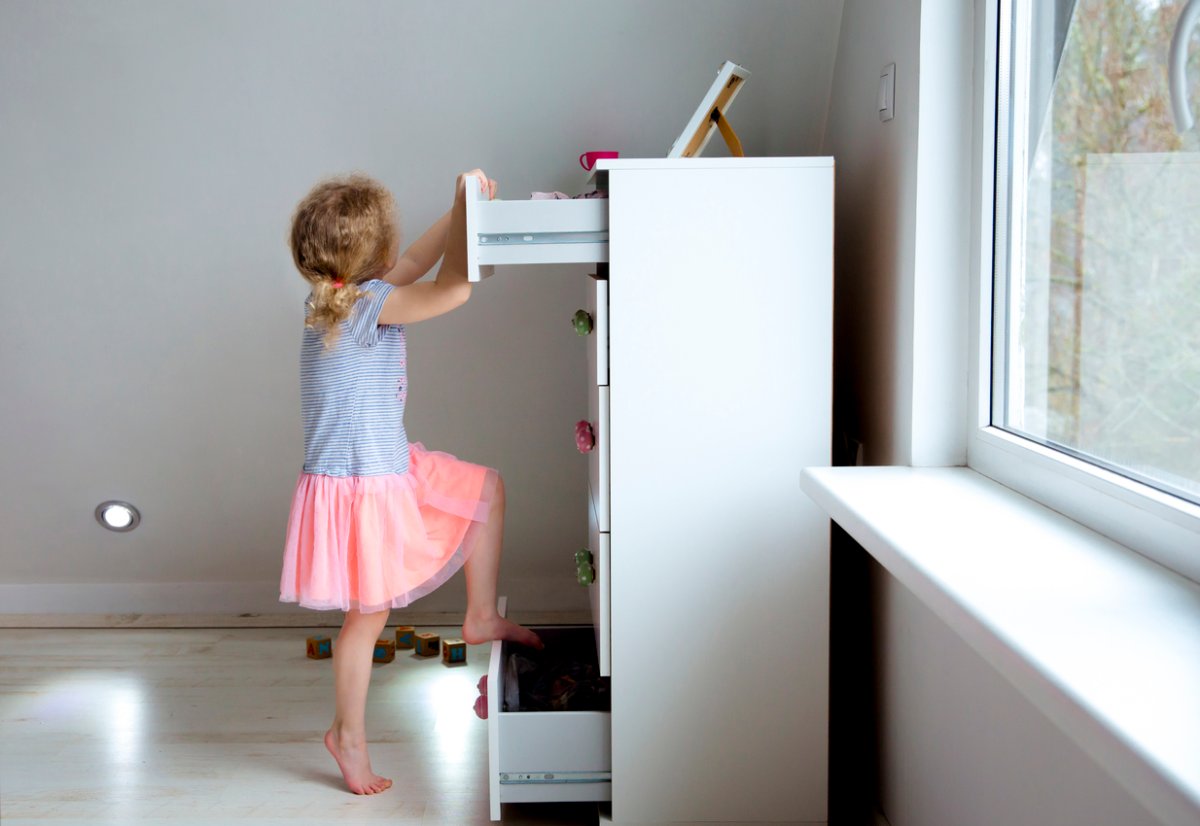We may earn revenue from the products available on this page and participate in affiliate programs. Learn More ›
Knowing how to anchor furniture to the wall (as well as televisions) is a crucial part of making a home safe for children. The U.S. Consumer Product Safety Commission reports that, on average, more than 22,000 people were treated for injuries sustained from tipped-over TVs, appliances, or furniture between 2018 and 2020, and 581 were killed. Almost half of those injured and 81 percent of the deaths were children.
While safety campaigns encouraging parents and others to anchor their furniture to the walls has shown some success (including a 55 percent decrease in tip-overs requiring emergency medical attention from 2011 to 2020), there is still a need for further legislation and education. One bill that recently passed the U.S. Senate—the STURDY Act—is intended to help limit injuries and deaths. This law requires dresser manufacturers to adhere to strict safety standards before their products can be approved for sale.
Even with older furniture, you can help prevent tip-overs at home by using anchors and safety straps for furniture and televisions to make sure that anything at risk of tipping over is securely mounted to the wall. Read on to learn how to anchor furniture and televisions to walls to prevent avoidable injuries.
Tools & Materials
Bobvila.com may earn a commission from purchases made through these links.
Project Overview
Working Time: 30 minutes to 1 hour
Total Time: 30 minutes to 1 hour
Skill Level: Beginner
Estimated Cost: $25 to $200
BEFORE YOU BEGIN
An impact driver or cordless electric drill can greatly simplify the task of anchoring furniture to a wall. However, if you do not have an impact driver or drill, you can use a screwdriver and rubber mallet.
The steps to anchor furniture or a TV shared below apply to drywall or plaster walls. If you have brick, block, or poured concrete walls, you may want to consider hiring a professional to help with the project. A hammer drill, masonry bit, masonry screws, and other special materials may be required.
Many wall-mount TVs come with mounting directions and hardware that’s made for the specific TV model. Make sure to follow the manufacturer’s directions for attaching the TV to any included hardware with the TV’s pre-drilled holes. For those who prefer a tabletop TV, there are wall safety straps available that can stabilize the TV.
Whether it’s included TV mounting hardware, wall safety straps, a French cleat, or furniture brackets, the following steps will walk you through how to safely attach them to your furniture and to a wall.
STEP 1: Locate a stud behind the furniture and drill pilot holes.

Furniture and televisions are heavy; if they are not properly secured into a stud, the anchor could simply rip out of the drywall from the force of the object tipping over. The same is true when using a French cleat or securing other heavy items like mirrors to the wall.
When anchoring furniture to the wall, start by locating the studs using a stud finder. After locating the stud, line the furniture bracket up over the stud, mark the spot with a pencil, and drill pilot holes for the screws. Use a drill bit that is smaller than the screws that will attach the bracket to the wall.
It’s imperative that you sink the screws into studs. Do not use regular drywall anchors for this purpose, as they are not designed to support the weight of toppling furniture or a TV.
RELATED: 5 Ways to Find a Wall Stud Without Using a Stud Finder
STEP 2: Secure the brackets to the wall.
Next, line up one of the TV or furniture brackets over the pre-drilled holes. Use an impact driver to drive screws through the holes in the bracket and into the wall. While you can use a screwdriver or a drill for this step, an impact driver can be helpful because it will work much like a hammer to really drive the screw into the wall studs.
If you’re wondering whether you can use nails instead of screws, it is best to stick with screws to secure furniture to a wall. Nails are not as strong as screws and cannot reliably support as much weight.
STEP 3: Line up the furniture or TV with the wall and mark where to secure the bracket.
If you are mounting a TV with included hardware, this step is easy. Simply match the pre-drilled holes in the back of the TV with the bracket installed in the previous step.
If you want to secure a dresser or shelf to the wall, line up the item with the bracket that’s now on the wall. When deciding where to place the anchor on the furniture, choose a solid section and avoid trying to attach the anchors to any flimsy panels or covers. In some cases, you may find that the best spot for the anchor is on the underside of the piece.
Use a pencil to mark the location for drilling holes on the furniture to attach the bracket.
STEP 4: Secure the bracket to the furniture or TV.

Just as you did when securing the bracket to the wall, drill pilot holes in the furniture item using a drill bit that is smaller than the screws you’ll be using. Once the holes are drilled, drive the furniture screws into the piece with an impact driver or drill and secure the bracket in place.
For those anchoring a TV to the wall, follow the manufacturer’s directions to attach the mounting screws to the TV. Some television anchoring kits also include a third bracket to attach to the back of the television console for added security.
STEP 5: Use the straps to attach the TV or furniture to the wall anchor.
Finally, move the television or furniture piece close enough to the wall so you’ll be able to attach the straps or cables to each bracket. To secure these furniture safety straps, hook one end through the bracket on the wall and the other through the bracket on the furniture item or television. Once they’re secure, tighten them to hold the piece in place and to keep it from tipping over.
Final Thoughts
Anchored furniture is safer for everyone, especially kids. The steps shared above walk through how to effectively secure furniture and a television to a wall, minimizing the chances of a tragic tip-over. Fortunately, anchoring furniture to the wall doesn’t take much time, and the benefits certainly outweigh the effort needed for this task.
After your furniture is mounted to the wall, be sure to check on the tightness of the straps and fasteners periodically to make sure nothing has shifted or changed.
RELATED: Childproofing Checklist


